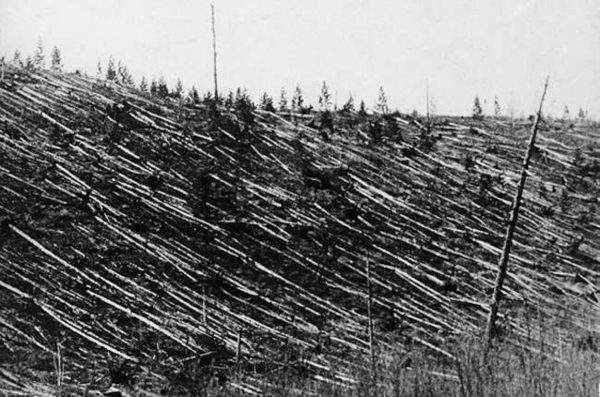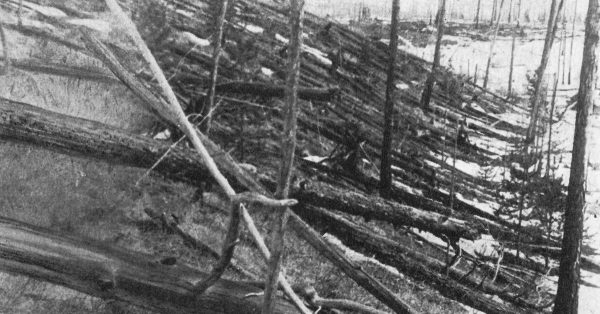If eighty million trees fall in a forest and no one is around, does it make a sound? In the case of the Tunguska Event, the answer is “Yes.” On June 30, 1908, an explosion in eastern Siberia flattened trees in 830 square miles of forest. Forty miles away, there was a flash of light and a sound like artillery file. Strangely, there was no crater left behind. Thank Agdy that no one lived close enough to be harmed
Eyewitnesses saw a bright light cross the sky, followed by an explosion with shock waves that toppled people and shattered windows.
S. Semenov reported,
[T]he sky split in two and fire appeared high and wide over the forest. The split in the sky grew larger, and the entire northern side was covered with fire. At that moment I became so hot that I couldn’t bear it as if my shirt was on fire; from the northern side, where the fire was, came strong heat. I wanted to tear off my shirt and throw it down, but then the sky shut closed, and a strong thump sounded, and I was thrown a few meters. I lost my senses for a moment, but then my wife ran out and led me to the house. After that such noise came, as if rocks were falling or cannons were firing, the earth shook, and when I was on the ground, I pressed my head down, fearing rocks would smash it. When the sky opened up, hot wind raced between the houses, like from cannons, which left traces in the ground like pathways, and it damaged some crops. Later we saw that many windows were shattered, and in the barn, a part of the iron lock snapped.
Chuchan of the Shanyagir tribe recalled,
We had a hut by the river with my brother Chekaren. We were sleeping. Suddenly we both woke up at the same time. Somebody shoved us. We heard whistling and felt strong wind. Chekaren said, ‘Can you hear all those birds flying overhead?’ We were both in the hut, couldn’t see what was going on outside. Suddenly, I got shoved again, this time so hard I fell into the fire. I got scared. Chekaren got scared too. We started crying out for father, mother, brother, but no one answered. There was noise beyond the hut; we could hear trees falling down. Chekaren and I got out of our sleeping bags and wanted to run out, but then the thunder struck. This was the first thunder. The Earth began to move and rock, the wind hit our hut and knocked it over. My body was pushed down by sticks, but my head was in the clear. Then I saw a wonder: trees were falling, the branches were on fire, it became mighty bright, how can I say this, as if there was a second sun, my eyes were hurting, I even closed them….
Wind came again, knocked us off our feet, struck the fallen trees.
We looked at the fallen trees, watched the tree tops get snapped off, watched the fires. Suddenly Chekaren yelled “Look up” and pointed with his hand. I looked there and saw another flash, and it made another thunder. But the noise was less than before.
Leonid Kulik led a Soviet expedition to the Tunguska area in 1927. He surmised that the explosion was due to a meteor. A mineralogist, he was looking for meteoric iron from the explosion to be used for industry. He also expected to find a crater from the impact, but there wasn’t one. Instead, he found a ground zero zone of five square miles of scorched, branchless, standing trees. Surrounding them, other felled trees radiated away from the center. A similar pattern resulted thirty-seven years later at Hiroshima after the atomic bombing.
Don Yeomans of NASA’s Jet Propulsion Laboratory explained, “Those trees acted as markers, pointing directly away from the blast’s epicenter. Later, when the team arrived at ground zero, they found the trees there standing upright – but their limbs and bark had been stripped away. They looked like a forest of telephone poles.” The shock waves from the blast at ground zero moved so fast that they tore off the branches before their momentum energy could knock over the trunks.
Later expeditions confirmed the meteoroid origins of the blast. An asteroid speeding at 33,500 miles per hour hit the Earth’s atmosphere. It exploded around 28,000 feet, which heated up the air to 44,500 degrees Fahrenheit. Coupled with the downward momentum, it produced a fireball with the power of 185 atomic bombs. Later expeditions found silicate, magnetite and nickel indicative of an extraterrestrial body. Yeomans concluded, “That is why there is no impact crater…. The great majority of the asteroid is consumed in the explosion.”
For years, the Tunguska Event remained mysterious. The lack of a crater or meteorites seemed like evidence against a collision. We should consider the technology of the time. Without radar or satellites, nothing monitored the remote region. Who would know what happened in the sky?



There are no voices yet... Post-script us a message below, won't you?